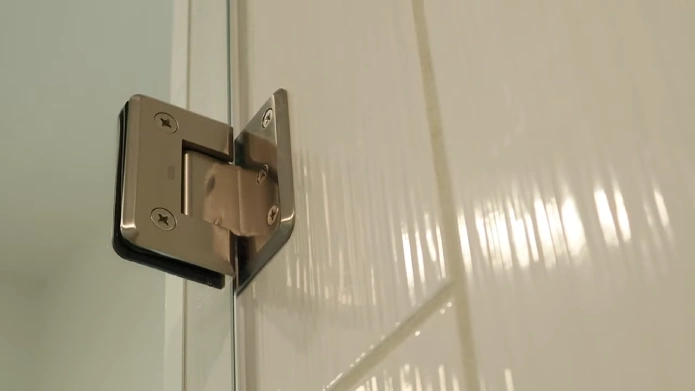Last Updated on October 16, 2023
Bathroom door hinges often require routine upkeep, but unfortunately it’s a task many of us neglect or get wrong. To keep your chrome, stainless steel, and brass-plated beauties sparkling without risking damage to the surface, you need to use special cleaning solutions.
As cleaning door hinges can be a tricky business, with the right know-how it is easy to keep your hardware gleaming. Whether you use home remedies like vinegar and water on chrome or commercial products for solid brass, find out which cleaning solutions are best suited to each of your unique materials.
With the right solution, you’ll be able to keep your bathroom door looking gorgeous without fear of staining or permanent damage. We have all sorts of tips and tricks up our sleeve for cleaning different types of hinges based on their material so they’ll look spick-and-span every time.
How to Clean Bathroom Door Hinges Based on their Material?
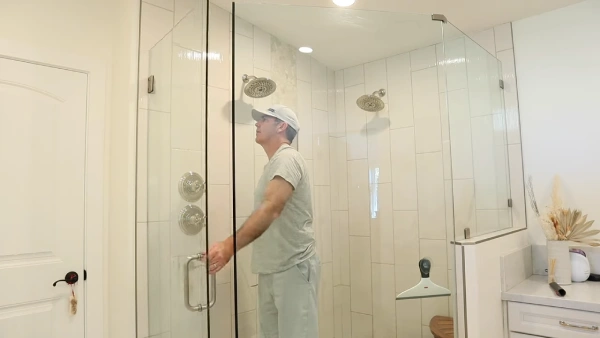
Your bathroom’s door hinges are an integral part of its overall design and functionality, so they need to look good and be easy to clean. Different door hinges are available for use in bathrooms, each offering different cleaning methods.
1. Chrome Hinges:
Cleaning chrome hinges installed in a bathroom can be a tricky process. Depending on the state of the hinges, the best cleaning methods can vary. There are two simple methods that can be used to effectively clean chrome hinges in a bathroom: vinegar & white water and baking soda.
Cleaning with Vinegar and White Water:
Step 1: Mix an equal part of white vinegar with warm water in a spray bottle.
Step 2: Spray the solution onto the chrome hinges and allow it to sit for around 20 minutes.
Step 3: Use a cloth or sponge soaked in warm water to wipe away any remaining residue from the hinge.
Step 4: Once the residue has been removed, wipe down the shower door hinge with a dry cloth or paper towel, restoring its shine.

Cleaning with Baking Soda:
Step 1: Begin by mixing together equal parts baking soda and warm water in a bowl until it forms a paste-like consistency.
Step 2: Apply the paste directly onto the chrome hinges using a soft cloth, scrubbing gently in circular motions until all dirt has been removed from the surface of the hinges.
Step 3: Rinse off with warm water, wiping away any excess paste residue with a damp cloth.
Step 4: Buff dry with another soft cloth or paper towel. This will restore some of its original shine.
2. Stainless Steel Hinges:
Stainless steel hinges are commonly installed in bathroom doors, offering a sleek and modern look. In order to keep them looking their best, they need to be cleaned regularly. There are 3 main methods of cleaning stainless steel hinges: using dish soap, vinegar, and club soda.
Cleaning with Dish Soap and Hot Water:
Step 1. Start by opening the glass door as wide as possible to gain access to the hinge.
Step 2. Take off the screws connecting the glass hinge plate from the frame with a screwdriver.
Step 3. If there are any plastic caps covering the screws, carefully pry these off with a flat-head screwdriver or butter knife.
Step 4. Place the hinge in a sink full of hot water and add a few drops of liquid dish soap or detergent to it.
Step 5. Allow soaking for 15 minutes before scrubbing with an old toothbrush or soft brush that has been dipped in the soapy water solution.
Step 6. Rinse off any excess suds with clean water, then dry the entire surface with another dry cloth before reinstalling it back on your door frame.
Step 7. If you’d like, you can apply some lemon oil furniture or WD-40 lubricant onto each hinge’s moving parts for extra protection against rusting or corrosion in high-humidity environments like bathrooms.

Cleaning with a Mixture of Olive Oil & Vinegar:
Step 1. Open up your bathroom door as wide as you can, so you can work on each hinge one at a time if necessary. Unscrew both sides of its hinge plate from the door frame with either an Allen wrench or a flathead screwdriver, depending on which screws were used during installation.
Step 2. Take one side out completely. Then make sure all plastic caps covering any exposed screws are removed for easier access when reattaching later on down the line later.
Step 3. Mix together equal parts olive oil (or vegetable oil) & white distilled vinegar in a bowl or container big enough for a cloth or brush to fit inside without spilling over onto the countertop area below.
Step 4. Scrub away dirt particles stuck to metal surfaces in circular motions using a rag dipped in the solution.
Step 5. Remove excess suds with clean water. Replace the original location at the bottom portion of the corner side frames after drying the entire plate section.
Step 6. Apply a few drops of WD-40 lubricant around each moving part of the shower door hinges themselves, if desired. A bonus is that WD can also be used to clean shower glass.
Cleaning with Club Soda for Spotless:
Step 1. Put on rubber gloves before beginning this process, as club soda can be caustic when it comes into contact with skin.
Step 2. Unscrew all screws holding the hinge onto the frame and remove it from its place carefully without damaging it in any way.
Step 3. Submerge the stainless steel hinge into a bucket filled with cold club soda and leave it overnight for deep cleaning action to take effect on stubborn stains and marks left behind by daily wear-and-tear usage.
Step 4. Take out of the bucket after 8 hours have passed and rinse off completely under running tap water before drying off completely with a soft cloth or paper towel.
Step 5. Reattach the door frame using all original screws, ensuring each one is tightened firmly but not overly to avoid further damage.
3. Brass-plated Hinges:
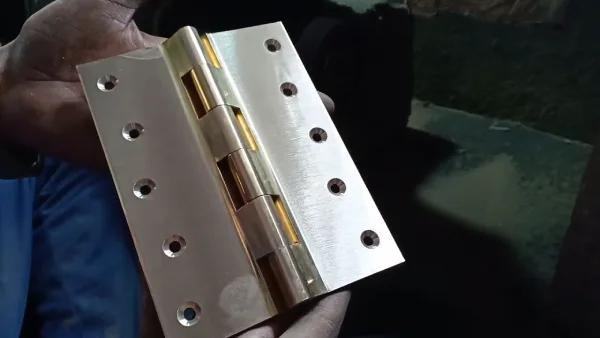
Brass-plated hinges can be found in many types of bathroom doors, such as those made from steel, zinc, or cast iron. As brass is a material prone to tarnishing and corrosion, it is important to clean your sliding shower doors regularly to ensure they are able to function properly.
We will go through two methods to clean brass-plated hinges using soapy water and ammonia and provide step-by-step instructions on how to do it.
Cleaning with Soapy Water:
Step 1: Begin by removing the screws that hold the hinge in place by using an appropriately sized screwdriver. Be sure to keep the screws somewhere safe, so they do not get lost.
Step 2: Make a warm soapy solution with a few drops of dish soap and hot water in either a bowl or bucket.
Step 3. Place the hinge into a bucket or sink full of hot soapy water. Make sure that all parts are submerged in water and allow it to soak for at least 15 minutes. This will help loosen any dirt or debris from its surface.
Step 4: After soaking, take a soft cloth and scrub gently at the hinge with a small amount of dish soap on the cloth. Try not to use too much force, as this could damage the finish of the brass plating.
Step 5: Rinse off all traces of soap with hot water from a garden hose or tap (if possible) before allowing it to air dry completely before reattaching it to the door frame.
Cleaning with Ammonia with a Toothbrush:
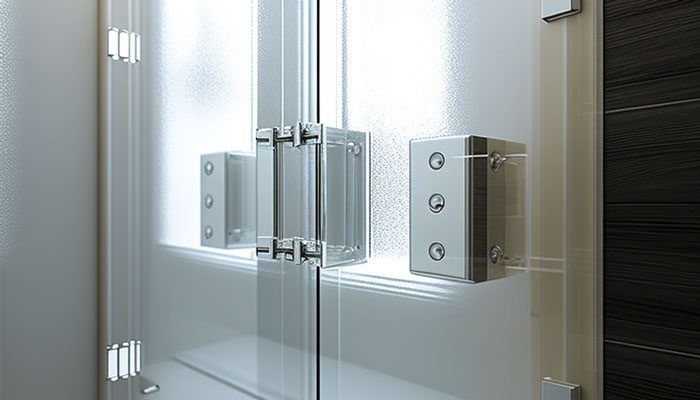
Step 1: Remove all screws holding down the unlacquered brass plate hinge as you did above. Keep these screws safe and away from potential moisture sources while you clean them later on.
Step 2: Put some rubber gloves on before handling any chemical cleaners, such as ammonia which can be hazardous if not handled correctly. Pour 1 part ammonia into 6 parts hot water in a bowl or bucket large enough to submerge the hinge in.
Step 3: Allow your brass plate hinge pieces to soak in this solution for about 10 minutes before taking out one part at a time using rubber gloves for protection against further contact with chemicals if necessary
Step 4. Scrub each piece gently but firmly using an old toothbrush soaked in more ammonia solution until any oxidation has been removed from its surface entirely.
Step 5: Rinse off any remaining residue with clean hot water and dry off completely with a lint-free cloth before reattaching it back onto your door frame.
4. Solid Brass Hinges:
Solid brass hinges are a great choice for bathroom doors due to their durability and aesthetic qualities. However, over time they can become tarnished due to exposure to water or dirt, so it is important to clean them regularly.
We will discuss 8 methods for removing solid brass hinges from bathroom doors and cleaning them.
Cleaning with Vinegar, Flour, and Salt:
Step 1: Make a paste mixture by combining equal parts of white vinegar, flour, and salt in a bowl until you get a thick consistency. We recommend using two tablespoons of each ingredient.
Step 2: Apply the paste onto the frameless shower doors with a cloth or brush so that all areas are completely covered.
Step 3: Let the paste sit on the hinges for at least 30 minutes before wiping off with a damp cloth or sponge.
Step 4: Once all of the paste has been wiped off, use fine steel wool to buff out any remaining residue on each hinge before drying with a clean cloth.

Cleaning with Baking Soda and Vinegar:
Step 1: Begin by mixing equal parts baking soda and white vinegar in a bowl until it becomes thick like toothpaste.
Step 2: Use an old toothbrush or soft bristle brush to apply the mixture onto the hinges evenly.
Step 3: Allow the mixture to sit on each shower enclosure for at least 10 minutes before scrubbing with steel wool to remove any remaining residue or dirt buildup on each hinge.
Step 4: Wipe down each hinge with a wet cloth or sponge so that all of the baking soda and vinegar solution is removed from each door hinge before drying with a clean towel.
Cleaning with Lemon and Salt:
Step 1. Start by cutting the lemon in half and removing the seeds from one half.
Step 2. Then, cover the flat side of the lemon with salt.
Step 3. Rub the lemon with salt across the hinge in a slow, circular motion. As you rub, add additional coats of salt to ensure complete coverage of the hinge surface.
Cleaning with Cream of Tartar:
Step 1. In a small bowl, mix two tablespoons of cream of tartar with one tablespoon of lemon juice and stir well.
Step 2. Rub the paste onto each side of the hinge using an old toothbrush or paper towel until it is fully coated.
Step 3. Allow it to sit for 30 minutes before wiping it away with a damp cloth.
Step 4. Once finished, use a soft dry cloth to remove any excess moisture and polish off any remaining residue on each side of the hinge. This will help protect them from further corrosion and rust while ensuring they continue to look new.
Cleaning with Yogurt:
Step 1. To remove solid brass hinges from a bathroom door, begin by unscrewing the mounting screws holding the hinge in place.
Step 2. Using a spatula or spoon, spread an even layer of plain yogurt onto both sides of the hinge.
Step 3. Allow the yogurt to sit on the hinge overnight before rinsing off with warm water.
Step 4. Use a soft toothbrush to get into any small crevices or hard-to-reach areas where yogurt may have collected during the drying process.
Step 5. Once clean, dry the hinges completely before reattaching them to the bathroom door frame.
Cleaning with Smear a Tomato-Based Product:
Step 1. Remove the screws that hold your brass hinge in place and remove it from the bathroom door frame.
Step 2. Apply a thin patina of ketchup, marinara sauce, tomato paste, or hot sauce onto both sides of your brass hinge using a paper towel or cloth rag.
Step 3. Allow this tomato-based product to remain on the hinge for around an hour or 60 minutes before scrubbing it off with warm soapy water and a soft cloth or sponge.
Step 4. Rinse once more and then dry completely prior to reattaching your solid brass hinges back onto your bathroom door frame.
Cleaning with Milk:
Step 1: Remove the hinges from the door. Take off the screws using a screwdriver or drill bit, then take the hinge off the door. Set aside any screws or washers that were attached to it.
Step 2: Clean away dirt and debris on the hinges using a damp cloth. Make sure to get into all of the crevices and corners to remove any built-up grime or particles that might be stuck there.
Step 3: Prepare a cleaning solution with equal parts water and milk in a small pot on the stovetop. Place the hinges in this mixture and bring it up to a boil, then reduce the heat to its lowest setting. Allow it to simmer for 10 minutes before taking out the hinges with tongs and examining them for cleanliness.
Step 4: If necessary, return them to their bath for further cleaning until they are restored back to their original shine. Once satisfied with your results, turn off the heat and rinse your hinges in cool running water before drying them off with a soft cloth or towel.
Step 5: Reattach your now clean brass hinges to your bathroom door’s frame using new screws or washers if needed. Enjoy your newly restored fixtures.
Cleaning with Commercial Cleaning Products:
Step 1: Shake the commercial cleaning product thoroughly before use and follow the manufacturer’s instructions for diluting it with water as necessary.
Step 2: Wipe down everything around the hinges with a damp cloth to remove any excess grime or dirt. This will help prevent dirt from getting into the crevices of the hinge and make it harder to clean later. Make sure not to get any soap or liquid on the actual hinges, though.
Step 3: Once all the surrounding surfaces are clean, apply the commercial cleaning product directly onto each individual hinge using a soft sponge or rag. Let sit for 5-10 minutes, depending on how dirty they are.
Step 4: Use an old toothbrush or similarly soft bristled brush to gently scrub away any tarnish, grime, and dirt that may have built up in between them and along their edges. If needed, add cleaner as you brush over them to ensure they come out looking brand new again when finished.
Step 5: Rinse off all the hinges with warm water and pat dry with a soft cloth before reinstalling them back onto the door. Regularly repeating this process every 6 months or so will help keep them looking new for years to come.
Can You Spray Olive Oil On Door Hinges?

Spraying olive oil on door hinges is an effective solution for fixing squeaking hinges. It can provide a proper lubricating layer between the metal surface of each hinge and allow it to move more smoothly.
Olive oil consists of various fatty acids, some of which can penetrate the small gaps in metals, providing them with adequate lubrication. In addition, olive oil also contains antioxidants that can protect the metal from corrosion and rusting.
Will Vinegar Take Paint Off Door Hinges?
Vinegar can be used to take the paint off door hinges without damaging the metal surfaces underneath. Vinegar is a strong acid that works by dissolving the bonds between molecules within paint layers.
When applied directly onto paint-covered areas such as door hinges, it will break down the outermost layer of paint, leaving behind just the metal surface underneath. However, it is important to make sure that vinegar is not left on too long as this could potentially damage or corrode metals if left unchecked.
Does WD-40 Work On Door Hinges?
WD-40 is a very effective product when it comes to keeping door hinges working properly and free of any grease or grime buildup over time. It creates a protective film on metal surfaces that prevents dirt and dust particles from settling in small spaces like hinge openings.
Does Vinegar Actually Remove Rust from Door Hinges?
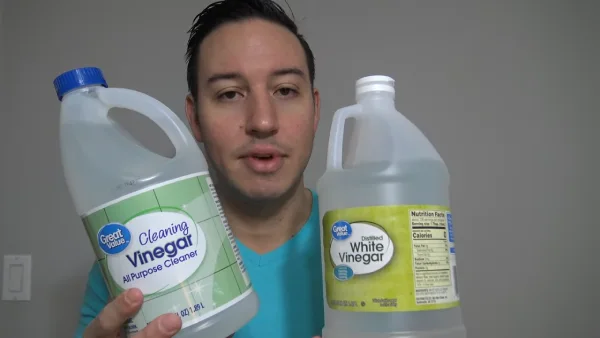
Vinegar has rust removal properties, making it useful for getting rid of rust from metal objects, including rusty door hinges. Vinegar and mild abrasives like baking soda, salt, or chalk powder form a paste that is easy to apply to rusted door hinges and scrub off with steel wool after 10 minutes until all the rust is gone.
Clean Your Bathroom Door Hinges Easily and Effectively
Bathroom door hinges covered in dust can make a room appear dirty and cluttered, even if the rest of the room is spotless. So it’s essential to know which cleaning products work best on each type of door hinge material to protect the finish and ensure longevity.
Whether it’s vinegar and white water for chrome hinges or baking soda for stainless steel ones, you can now keep your door hinges looking like new with just a few simple steps. Failing to use the right cleaners can cause damage to the finish or rusting that could lead to costly replacement costs.
Following these guidelines will help you keep your bathroom door hinges looking great while providing years of reliable service.

